Floral Motifs on Early Chintz
Fritillaria meleagris - Checkered Fritillaria
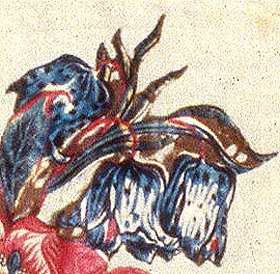
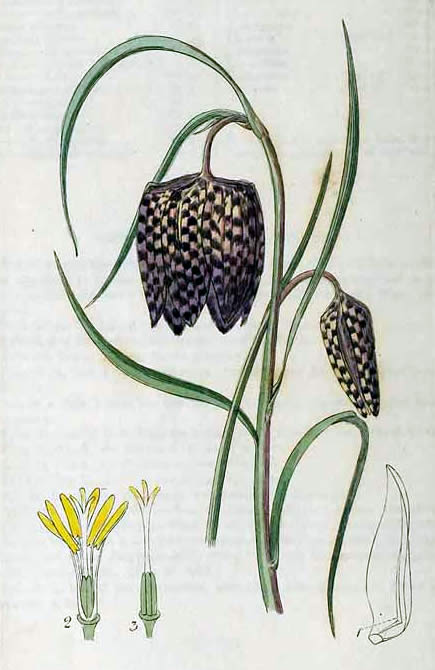
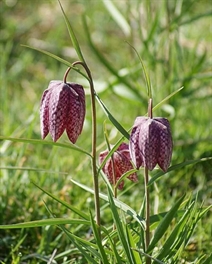
Fritillaria meleagris (Checkered Fritillaria) growing in modern garden.
Fritillaria meleagris (Checkered Fritillaria) on the Daughters of the American Revolution Museum, Fish Family Album Quilt, Object Number 5254.
Fritillaria meleagris (Checkered Fritillaria) from W. Baxter, British phaenogamous botany, t. 1080, vol.1: t. 1 (1834-1843).
Common Names: Checkered fritillaria, guinea-hen flower, checkered lily, snake's head fritillary, chess flower, frog-cup, leper lily
Description: Fritillaria meleagris (Checkered Fritillaria) is a member of the Lily Family (Liliaceae). The Hortus Kewensis, ed. 2, vol. 2 recorded that Fritillaria meleagris is a native of Britain.
Flowers for which Fritillaria meleagris (Checkered Fritillaria) may be mistaken:
Quilts with this Fritillaria meleagris (Checkered Fritillaria):
Printed cotton with this Fritillaria meleagris (Checkered Fritillaria):
Printed cotton with a different Fritillaria meleagris (Checkered Fritillaria) motif:
Printed cotton with a third Fritillaria meleagris (Checkered Fritillaria) motif (no picture available at this time):
Description: Fritillaria meleagris (Checkered Fritillaria) is a member of the Lily Family (Liliaceae). The Hortus Kewensis, ed. 2, vol. 2 recorded that Fritillaria meleagris is a native of Britain.
Flowers for which Fritillaria meleagris (Checkered Fritillaria) may be mistaken:
Quilts with this Fritillaria meleagris (Checkered Fritillaria):
- Daughters of the American Revolution Museum, Fish Family Album Quilt, Object Number 5254, c. 1842-1844
Printed cotton with this Fritillaria meleagris (Checkered Fritillaria):
- None known at this time
Printed cotton with a different Fritillaria meleagris (Checkered Fritillaria) motif:
- The Victoria and Albert Museum, Design for a Chintz, Watercolor by Peter, French, Object Number D.1433-1908, (made) 1794
Printed cotton with a third Fritillaria meleagris (Checkered Fritillaria) motif (no picture available at this time):
- Colonial Williamsburg, Wood Block Printed Cotton with Pencil Blue, Accession Number 1974-15, 1760-1790
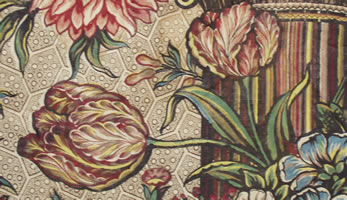
While the tulip's bell shaped flowers resemble those of Fritillaria meleagris, there are no known spotted tulips. Also, Fritillaria meleagris has leaves on its flower stems while tulip leaves are basal.
Additional Fritillaria meleagris (Checkered Fritillaria) Motifs

Fritillaria meleagris (Checkered Fritillaria) from the Victoria and Albert Museum, Design for a Chintz, Watercolor by Peter, French, 1794.
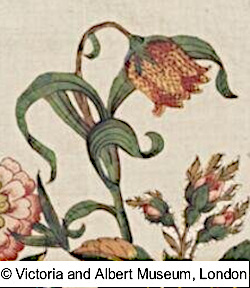
Fritillaria meleagris (Checkered Fritillaria) from the Victoria and Albert Museum, Bed Cover, Given by Alice B. Kershaw, 1811-1815 (made)
Quilts with this Fritillaria meleagris (Checkered Fritillaria):
Printed cotton with this Fritillaria meleagris (Checkered Fritillaria):
- Victoria and Albert Museum, Bed Cover, Accession Number T.382-1960, 1811-1815 (made)
Printed cotton with this Fritillaria meleagris (Checkered Fritillaria):
- None known at this time
© Updated 9/7/2025 Author: Terry Terrell